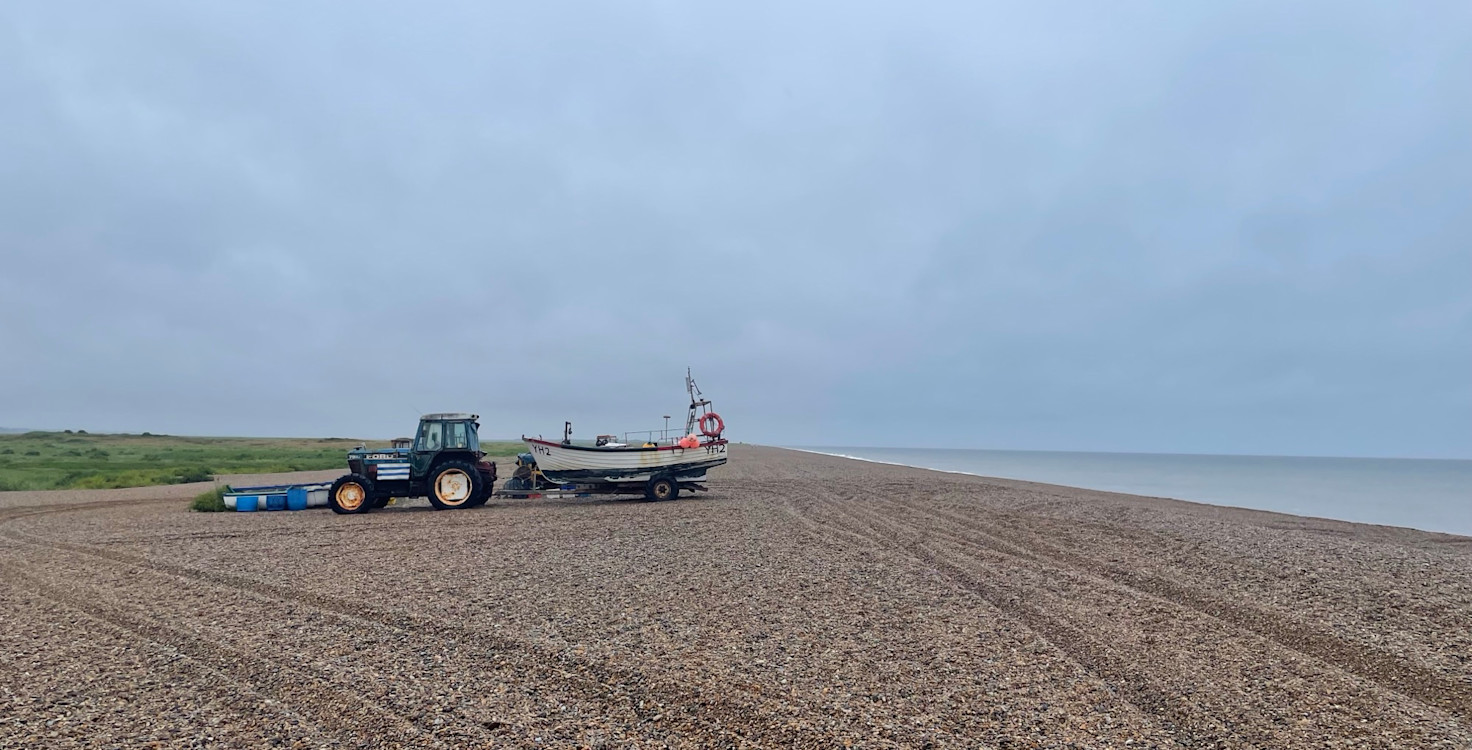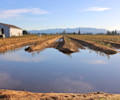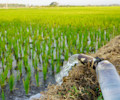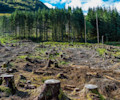“This is summer in Britain for you” says Allie Wharf, CEO of Norfolk Seaweed, as we are battling the rain in Blakeney harbour in Norfolk, in mid-July. But even the weather did not diminish my enthusiasm for the day as I was here to learn about a promising solution for land-based farming and aquaculture: seaweed.
I got the chance to join a field trip led by WWF UK to explore how seaweed farmed in the UK could support the transition to regenerative farming. WWF UK has been collaborating with partner organisations on a one-year trial to evaluate the potential of seaweed biostimulants in reducing synthetic fertiliser usage and nitrogen/phosphorus (N/P) pollution on a Norfolk farm.
Unlike terrestrial crops, seaweed does not require fertiliser, pesticides, freshwater, or land to grow – making it easier to scale production. Seaweed-based biostimulants enhance plants' efficiency in absorbing N/P, thus enabling farmers to decrease their reliance on synthetic, high-carbon fertilisers. If adopted on a larger scale, this approach could lower nutrient inputs, promote soil recovery, and mitigate pollution in freshwater and coastal areas. While seaweed biostimulants already exist, they usually utilise wild-collected species like Ascophyllum nodosum. This project is unique in its focus on testing seaweed species suitable for regenerative ocean farming along UK coasts. By providing evidence that farmed seaweed biostimulants can reduce farms’ carbon footprint and potentially lower farming costs, this initiative aims to bolster market support for UK seaweed farmers.
Funded by The Co-op Foundation via their Carbon Innovation Fund, this one-year trial is part of WWF UK’s Wholescape Programme, which emphasises that land and marine ecosystems’ health are interconnected and seeks to address the triple challenge of averting dangerous climate change, reversing biodiversity loss and supporting the wellbeing of communities.
Alongside WWF UK, all actors of the seaweed value chain were present: seaweed farmers (Norfolk Seaweed), seaweed processors (Eco-Cascade and Biotechnica), as well as large retailers interested in the potential of seaweed-based products, such as Tesco and the John Lewis Partnership.
Why should investors take notice
Investors have a crucial role to play in fostering sustainable agricultural practices. Seaweed biostimulants offer a potential solution to reduce the reliance on synthetic fertilisers, thus addressing one of the most significant environmental challenges in agriculture. Early observations suggest that seaweed biostimulants can improve plant and soil health notably by increasing soil carbon content, thereby contributing to climate change mitigation.
Furthermore, there is significant potential for seaweed-based products to capture a substantial share of the agricultural inputs market. Overall, supporting projects such as this seaweed biostimulant trial aligns with global trends towards regenerative agriculture, which favours practices that improve soil health and biodiversity on and around farms.
First-hand experience of the seaweed value chain
A highlight of the day was witnessing the full chain of seaweed use – from its offshore growth in the coastal Norfolk waters to its application in agriculture. Following a coastal walk, we spent the afternoon visiting the spring barley trial site at the Holkham Estate, where the seaweed biostimulant has been applied with regimes of reduced fertiliser application. This provided a tangible sense of the project's potential – and of its limitations.
It is important to note that seaweed science is still developing: current research focuses on understanding its polymer structure and high carbohydrate content. Processing seaweed involves energy-intensive freezing or fermentation methods, with the latter being preferred for efficiency. As illustrated by the various actors joining this field trip, collaborative efforts amongst numerous stakeholders are required to make this initiative successful. There are also regulatory hurdles to developing the seaweed farming market: Willy Athill and Allie Wharf, managers of Norfolk Seaweed, explained that it took them three years to be granted a 25-hectare licence to farm seaweed – their hope is to expand this to 50 hectares in the future.
Importantly, seaweed farming needs to remain commercially viable for farmers themselves, and the users of the biostimulant: this is why Willy and Allie decided to combine seaweed and oyster farming. This combined form of aquaculture is, in their eyes, a way for the sea to recover from decades of overuse and pollution. WWF UK is also promoting this multi-trophic aquaculture production to enable a richer ocean biodiversity. It was very potent to me to hear from farmers themselves, who have been living on the Norfolk coast most of their lives, about the multi-faceted threats of climate change: growing ocean temperatures are likely to alter seaweed growth.
"The seabed in the North Sea has been overused over the last 150 years and it is now a desert. Our belief is that with 50 ha of seaweed farm being protected, we can turn it back into a wonderland" – Willy Athill, Norfolk Seaweed
The passion and dedication of the seaweed farmers, processors, and academic partners was particularly inspiring. Further down the value chain, I found it encouraging that some of the largest UK retailers are interested in seaweed, and in finding ways to produce food more sustainably.
Looking ahead: Hopes for the future
The day ended at the University of East Anglia, where academics, the Centre for Environment, Fisheries and Aquaculture Science (CEFAS) and the Biotechnica team shared early insights from the trial and their prospects for the future.
As research on the use of seaweed as a biostimulant continues, there is great potential for this innovative approach to transform agricultural practices. The final results of this trial, expected in late 2024/early 2025 will provide critical insights into the effectiveness and environmental benefits of seaweed-based biostimulants. As the owner of the Holkham Estate explained, the success of this project does not simply boil down to increased yields: improved soil health (measured as an increase in the portion of organic matter available to soil microbes) as well as an improved quality of the barley crop (assessed across 23 different nutrients) would also be valuable results. CEFAS, an executive agency of the UK Department for Environment, Food & Rural Affairs (Defra), is leading a research project aiming to conduct a Life Cycle Analysis (LCA) model for the use of seaweed as a biostimulant, as well as to compare the use of seaweed biostimulant versus synthetic fertilisers.
Interestingly, the potential of seaweed extends far beyond biostimulants. As a versatile and sustainable resource, seaweed holds promise for various applications within food systems and as a broader climate solution. Seaweed is often talked about as a feed additive given to cows to reduce their methane emissions, a greenhouse gas 80 times more potent than carbon. However, seaweed used as feed additives are a different species from the sugar and winged kelp species used in this trial – noting that there exist 12,000 species of seaweed.
In a nutshell, this site visit left me hopeful for the future. This WWF UK Seaweed Biostimulant Project represents a collaborative effort to explore and harness the potential of natural resources to address some of the most pressing environmental challenges of our time – the overuse of synthetic fertilisers, soil pollution and, overall, the need for more regenerative practices.
FAIRR insights are written by FAIRR team members and occasionally co-authored with guest contributors. The authors write in their individual capacity and do not necessarily represent the FAIRR view.











